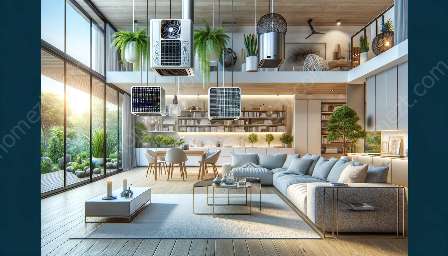When it comes to ensuring healthy indoor air quality and creating an intelligent home design, the choice between passive and active ventilation systems plays a crucial role. Both systems offer unique features and benefits, and understanding their differences is essential in making informed decisions for your living space.
Passive Ventilation Systems
Passive ventilation systems rely on natural forces, such as wind and buoyancy, to circulate air within a building. These systems do not require mechanical or electrical components to operate, making them energy-efficient and environmentally friendly. The main components of passive ventilation systems include vents, windows, and strategically placed openings that facilitate the flow of air.
One of the most significant advantages of passive ventilation systems is their ability to provide continuous air circulation without relying on external power sources. This not only reduces energy consumption but also contributes to a quieter and more peaceful living environment. Additionally, passive systems can be seamlessly integrated into architectural designs, allowing for a more aesthetically pleasing and unobtrusive solution to indoor air quality.
However, the effectiveness of passive ventilation systems heavily depends on factors such as building orientation, prevailing winds, and local climate conditions. Sufficient airflow may not always be guaranteed, especially in areas with minimal wind or extreme weather conditions. As a result, passive systems may not always provide consistent air quality control, and additional measures may be required to ensure optimal indoor air quality.
Active Ventilation Systems
Unlike passive systems, active ventilation systems require mechanical or electrical components to facilitate air exchange and circulation. These systems often include fans, blowers, and ductwork to actively move air throughout the building. The use of technology allows for greater control and customization, enabling homeowners to adjust ventilation levels based on specific air quality requirements and occupancy patterns.
Active ventilation systems are especially effective in addressing indoor air pollutants and maintaining consistent air quality levels. By continuously exchanging stale air with fresh outdoor air, these systems can help prevent the buildup of harmful contaminants and allergens, thereby promoting a healthier indoor environment. Additionally, the ability to incorporate filtration and purification components further enhances the air quality benefits of active systems.
While active ventilation systems offer precise control over indoor air quality, they typically consume more energy compared to passive systems. The operation of mechanical components adds to overall energy consumption and may result in higher utility costs. Furthermore, the installation and maintenance of active systems often require professional expertise, which can contribute to initial investment and long-term expenses.
Intelligent Home Design Integration
When considering the integration of ventilation systems into intelligent home designs, both passive and active systems present unique opportunities and challenges. Passive ventilation systems complement sustainable and eco-friendly home designs, offering a seamless blend of aesthetics and functionality. By maximizing natural airflow and minimizing reliance on external energy sources, passive systems align with the principles of intelligent and energy-efficient home design.
On the other hand, active ventilation systems provide a foundation for smart and responsive indoor air quality management. With the integration of sensor technology and automated controls, active systems can adapt to changing environmental conditions and user preferences, enhancing the overall intelligence of the home. This level of integration aligns with the trend of creating interconnected and sensor-equipped homes that prioritize comfort, health, and efficiency.
Choosing the Right System for Your Space
Ultimately, the selection of a ventilation system should be based on an assessment of specific requirements, environmental factors, and design objectives. Passive ventilation systems are well-suited for locations with favorable natural ventilation conditions and a focus on sustainability. They offer a balance between energy efficiency and architectural harmony, making them an attractive choice for certain architectural styles and climates.
Conversely, active ventilation systems are ideal for environments where precise control over indoor air quality is essential, such as in urban areas with higher pollution levels or in buildings with limited natural ventilation opportunities. By leveraging advanced technologies, active systems provide a proactive approach to air quality management, addressing the diverse needs of modern living spaces.
As the demand for intelligent home designs and enhanced indoor air quality continues to grow, the integration of ventilation systems will play a pivotal role in shaping the future of residential living. Whether through the utilization of natural forces or the application of advanced technologies, the convergence of passive and active ventilation systems will contribute to healthier, more sustainable, and intelligently designed homes.


